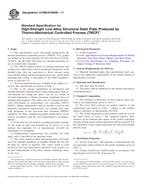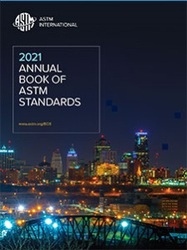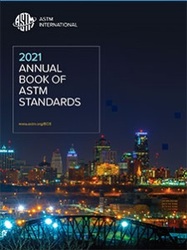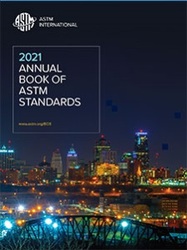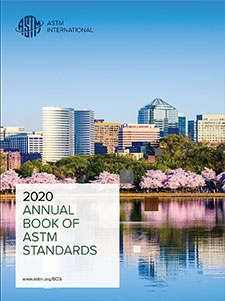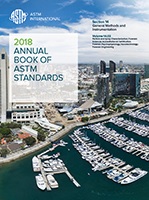Description
1.1 This specification covers steel plates produced by the thermo-mechanical controlled process (TMCP). Five grades are defined by the yield strength: 50 [345], 60 [415], 65 [450], 70 [485], and 80 [550]. The plates are intended primarily for use in welded steel structures.
1.2 The TMCP method consists of rolling reductions and cooling rate controls that result in mechanical properties in the finished plate that are equivalent to those attained using conventional rolling and heat treatment processes, which entail reheating after rolling. A description of the TMCP method is given in Appendix X1.
1.3 The maximum thicknesses available in the grades covered by this specification are shown in Table 1.
1.4 Due to the special combination of mechanical and thermal treatment inducing lower rolling temperatures than for conventional hot rolling the plates can not be formed at elevated temperatures without sustaining significant losses in strength and toughness. The plates may be formed and post-weld heat-treated at temperatures not exceeding 1050°F [560°C]. Higher temperatures may be possible if proven that minimum mechanical characteristics are retained after tests with specimens in the post-weld heat treatment (PWHT) condition. For flame straightening higher temperatures can be used in accordance with the steel manufacturer's recommendations.
1.5 If the steel is to be welded, a welding procedure suitable for the grade of steel and intended use or service is to be utilized. See Appendix X3 of Specification A6/A6M for information on weldability.
1.6 Supplementary requirements are available but shall apply only if specified in the purchase order.
1.7 The values stated in either inch-pound-units or SI units are to be regarded separately as standard. Within the text, the SI units are shown in brackets. The values stated in each system are not exact equivalents; therefore, each system is to be used independently of the other, without combining values in any way.
TABLE 1 Chemical Requirements (Heat Analysis)
| Element | Content in [%] | ||||
| Grade 50 [345] | Grade 60 [415] | Grade 65 [450] | Grade 70 [485] | Grade 80 [550] | |
| Thickness | Max 4 in. [100 mm] |
Max 4 in. [100 mm] |
Max 3 in. [75 mm] |
Max 2 in. [50 mm] |
Max 1 in. [25 mm] |
| Carbon, max | 0.14A | 0.16 | 0.16 | 0.16 | 0.16 |
| Manganese | 0.70–1.60 | 0.80–1.70 | 0.80–1.70 | 0.80–1.70 | 1.00–2.00 |
| Phosphorus, max | 0.030 | 0.030 | 0.030 | 0.030 | 0.030 |
| Sulfur, max | 0.020 | 0.020 | 0.020 | 0.020 | 0.020 |
| Silicon | 0.15–0.50 | 0.15–0.50 | 0.15–0.50 | 0.15–0.50 | 0.15–0.50 |
| Copper, max | 0.35 | 0.35 | 0.35 | 0.35 | 0.35 |
| Nickel, max | 0.30 | 0.70 | 0.70 | 0.70 | 0.70 |
| Chromium, max | 0.30 | 0.30 | 0.30 | 0.35 | 0.40 |
| Molybdenum | 0.10 | 0.20 | 0.25 | 0.30 | 0.40 |
| Columbium, max | 0.05 | 0.05 | 0.05 | 0.05 | 0.10 |
| Vanadium, max | 0.08 | 0.008 | 0.08 | 0.09 | 0.09 |
| Aluminium, min | 0.020 total or 0.015 solubleB |
0.020 total or 0.015 solubleB |
0.020 total or 0.015 solubleB |
0.020 total or 0.015 solubleB |
0.020 total or 0.015 solubleB |
| Boron, max | 0.002 | 0.002 | 0.002 | 0.002 | 0.002 |
A When Supplementary Requirement S75 is ordered the carbon content is 0.16 % max.
B By agreement the steel may be produced with titanium, in which case the minimum aluminum content shall not apply. When this option is exercised, the titanium content, by heat analysis, shall be 0.006 % to 0.02 %, and the actual titanium content shall be reported on the test report.
Product Details
- Published:
- 07/01/2011
- Number of Pages:
- 4
- File Size:
- 1 file , 150 KB

